Why you can trust Tom's Hardware
As with the GeForce RTX 3080 FE review, we ran additional tests on some other games and graphics benchmarks. This includes all the major (for the US anyway) ray tracing enabled games, several DLSS-enhanced games, and a few other recent releases. Oh, and we added Crysis Remastered because everyone loves a good meme. Can it run Crysis Remastered? Yes! Though not at 4K with maximum quality and 60 fps.

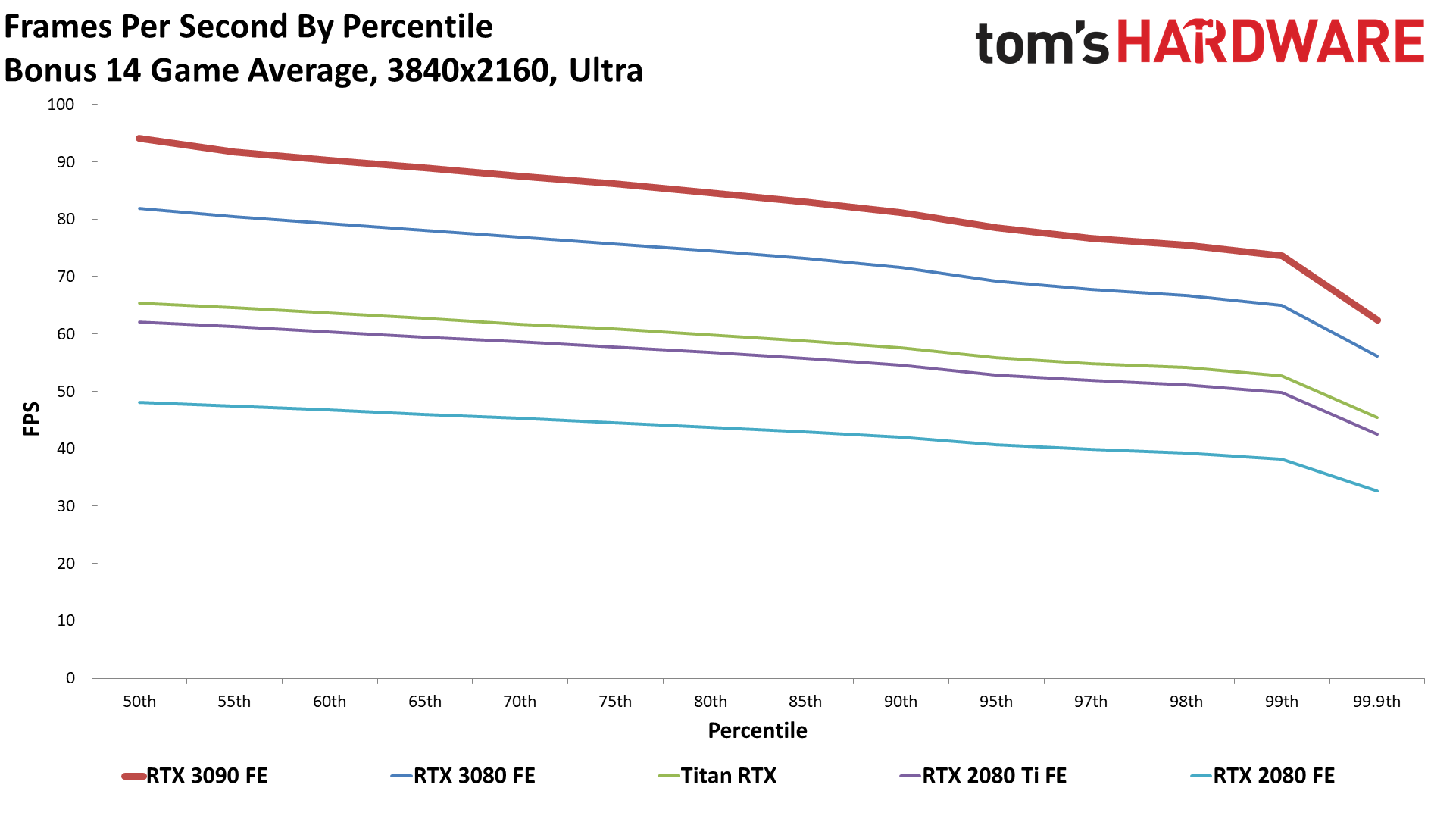
Starting with the overall average again, we took the average fps of all 15 games and graphics tests. We ran some of the tests at multiple settings and included all results in the average. With this expanded set of games, the RTX 3090 FE stretches its lead over the 3080 just a bit to 14.4% — still within that 10-15% range.
The RTX 3090 is also 43% faster than the Titan RTX, 50% faster than the RTX 2080 Ti, and nearly double the performance of the RTX 2080 FE. If you're thinking about upgrading from any of those earlier GPUs, you'll definitely notice the increased performance. But then, you'd notice the jump to the RTX 3080 as well. Let's look at the individual results.
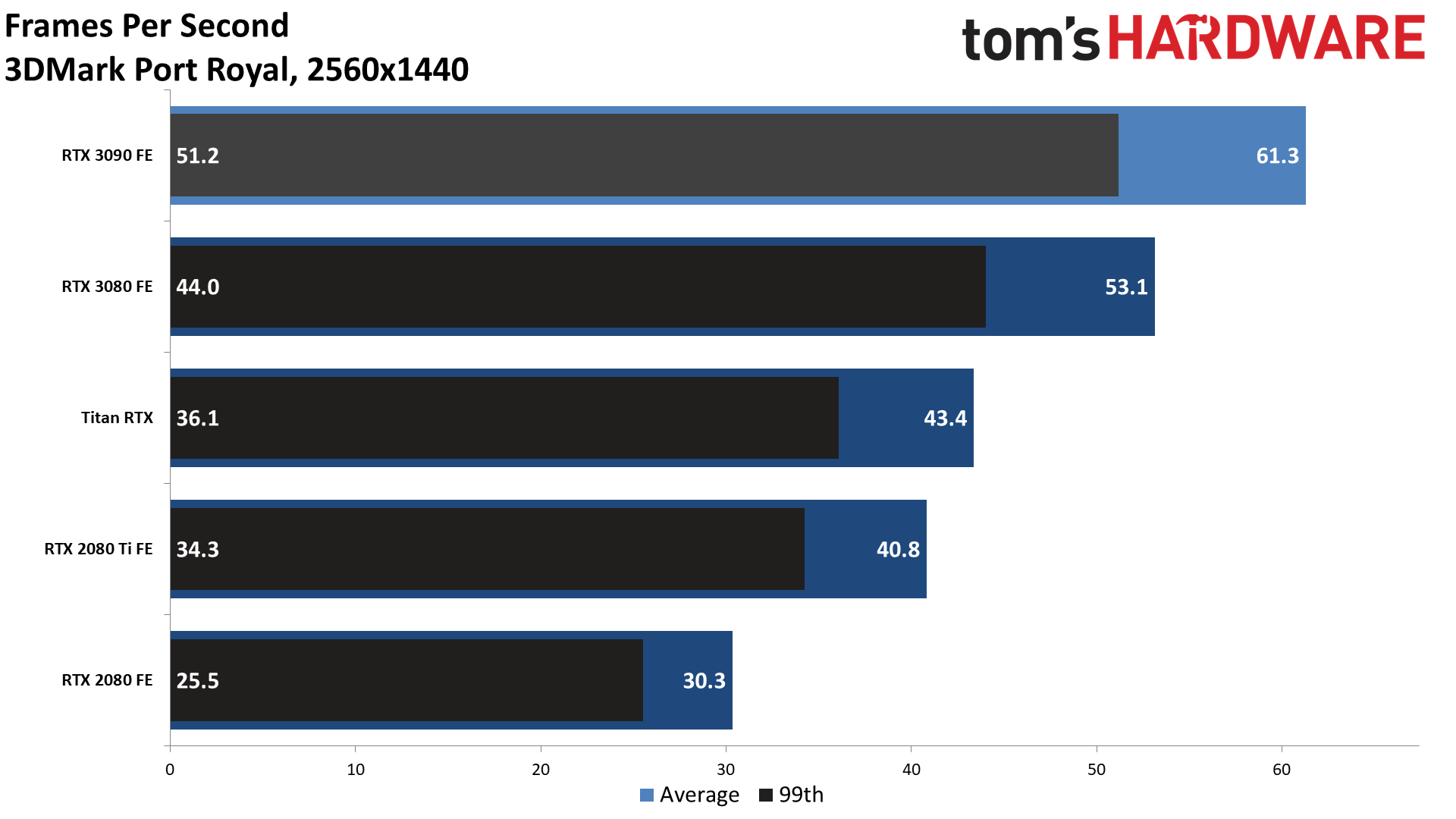
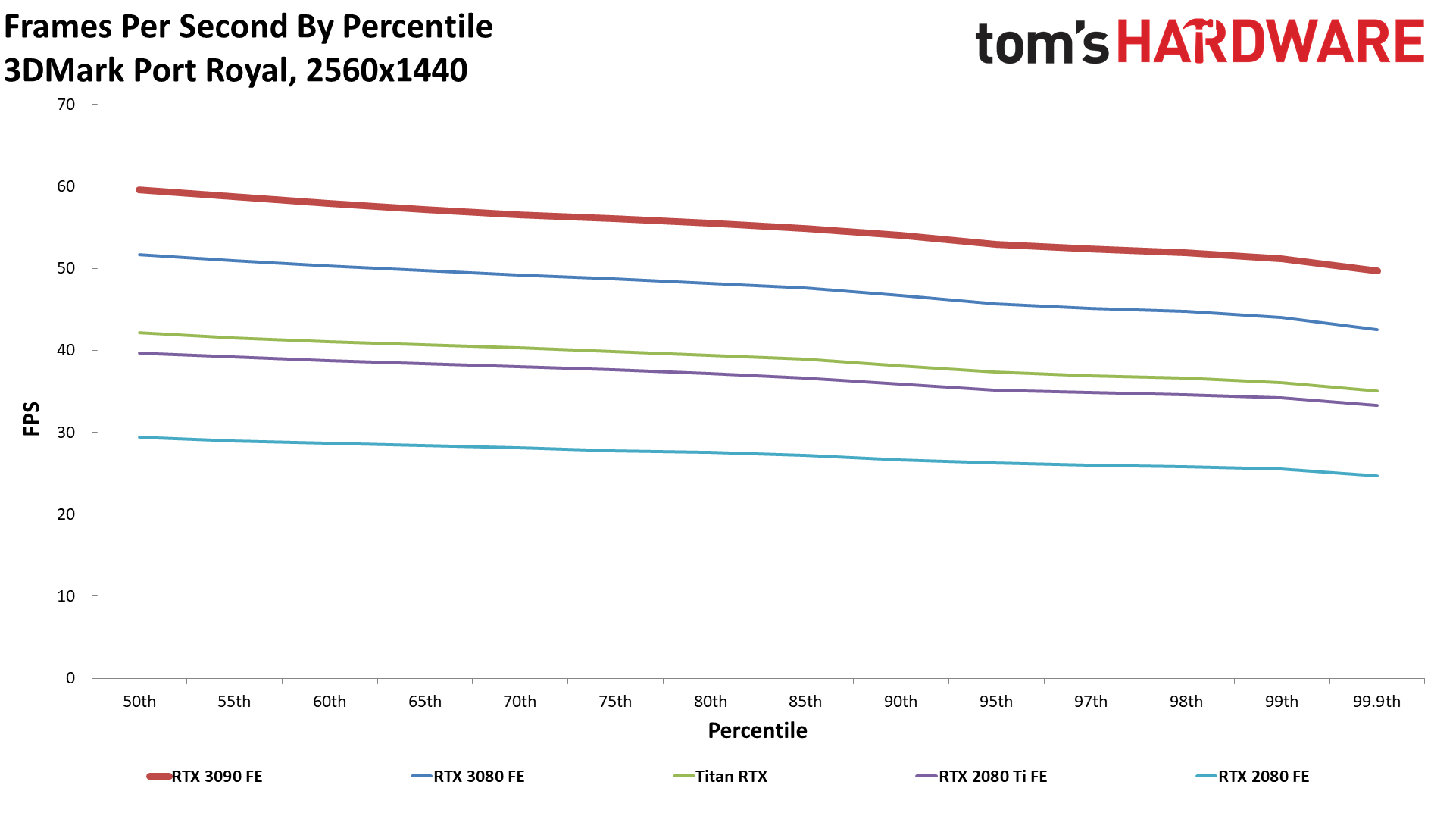
We captured frametimes from 3DMark Port Royal rather than using it's built-in score, since we want minimum fps as well. The RTX 3090 is the first GPU to break 60 fps at stock clocks in Port Royal, and it comes out 15% ahead of the 3080. Generally speaking, it ends up being a pretty decent estimate of overall performance with ray tracing, though we wouldn't want to rely on any single benchmark.
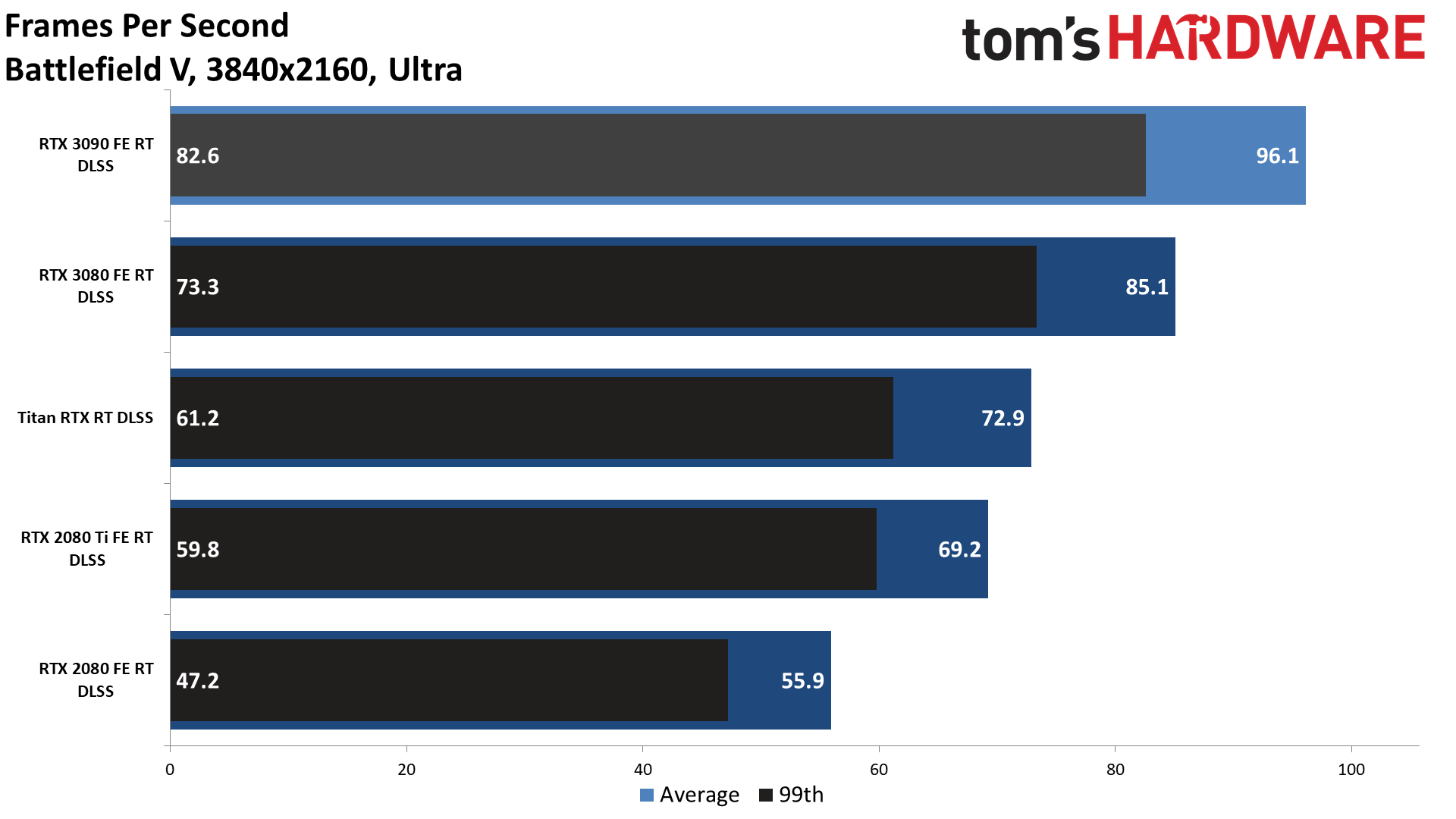
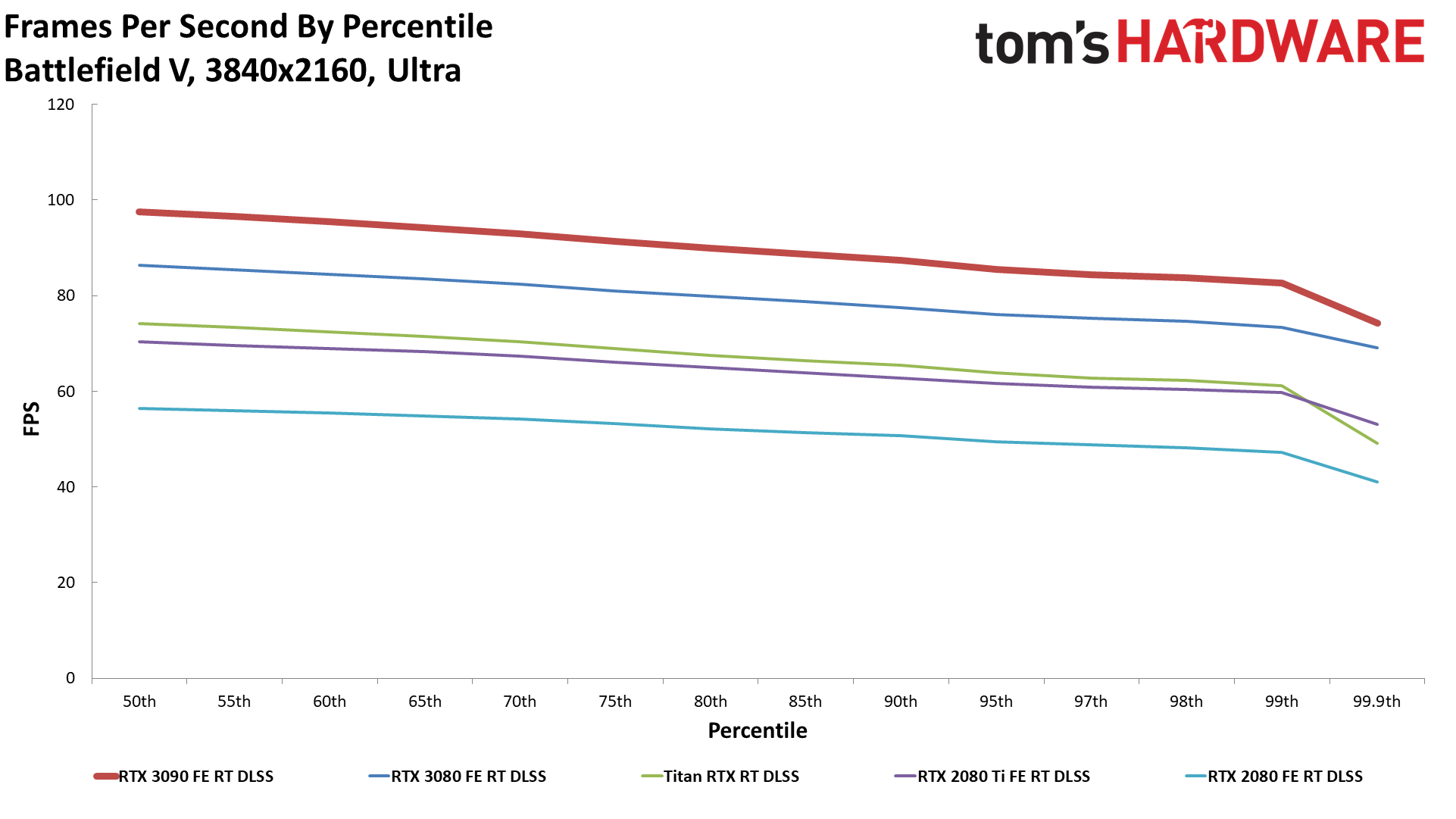
Battlefield V with DirectX Raytracing (DXR) reflections and DLSS enabled was barely above the 60 fps mark when it first came out, using an RTX 2080 Ti. With the 3090, it's now close to hitting 100 fps. This is in a singleplayer mission, however — we know the multiplayer mode can be quite a bit more demanding, but even with ray tracing enabled, you should now be able to get 60 fps or more in most areas.
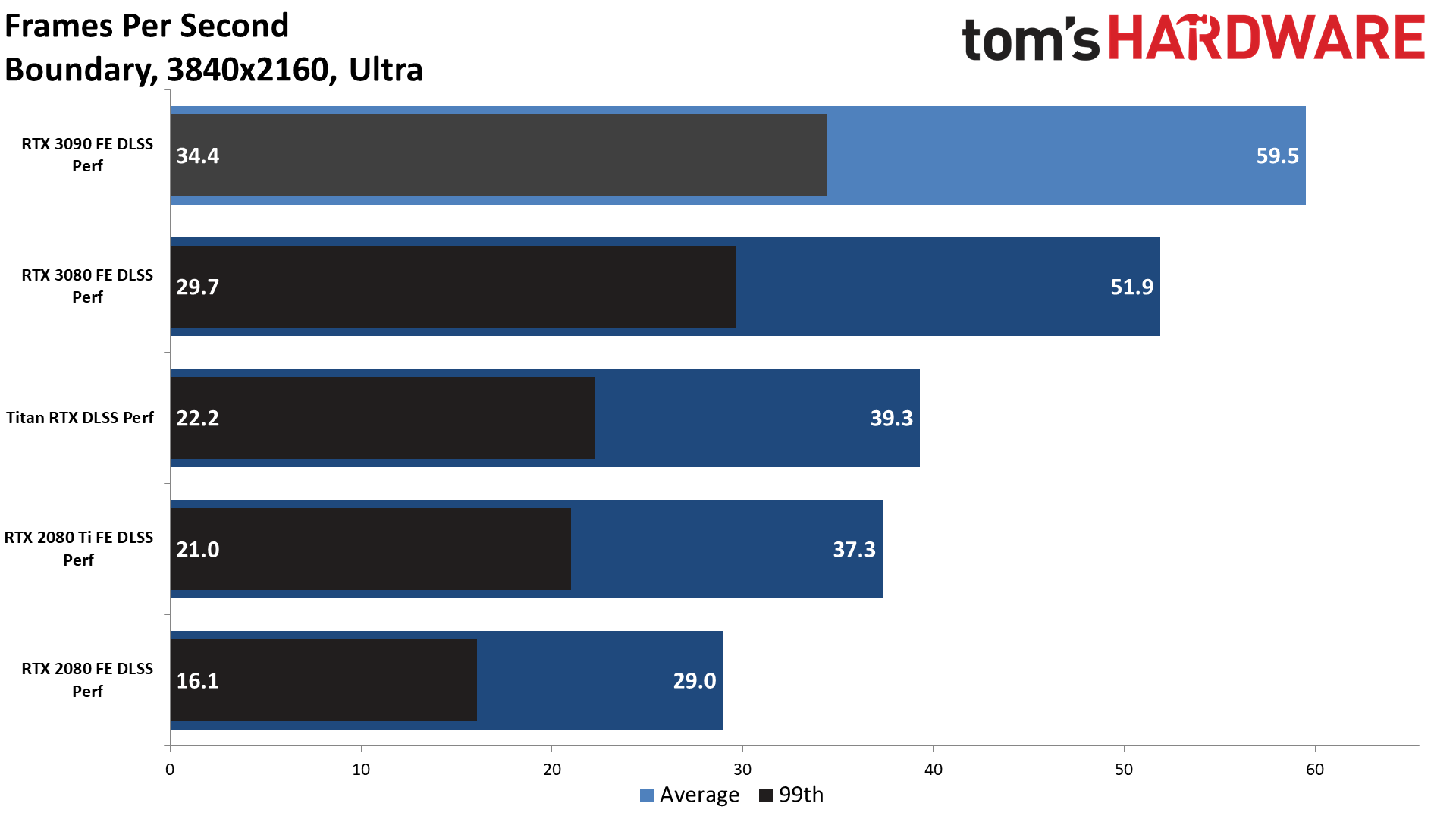
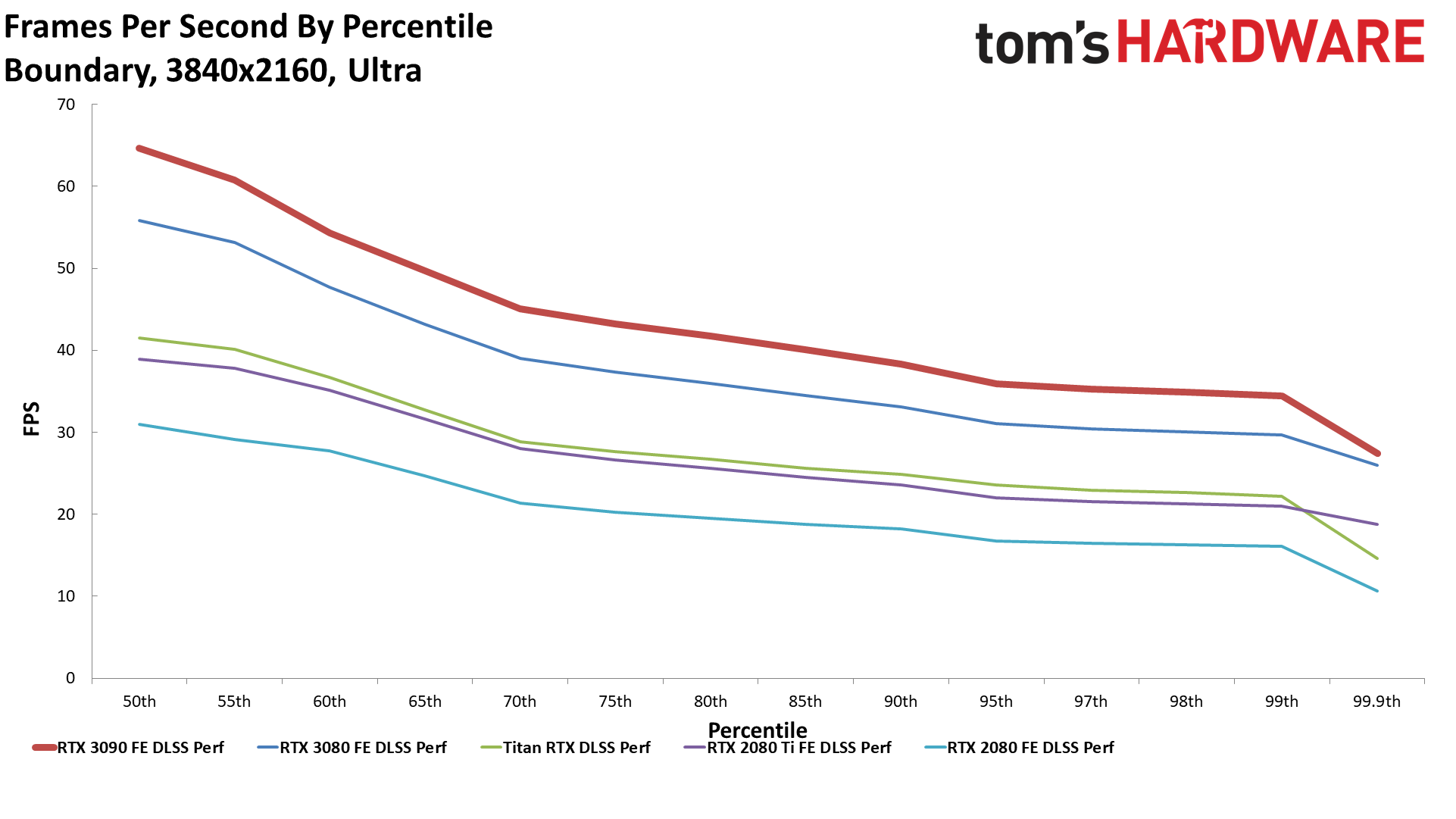
The Boundary Benchmark from Studio Surgical Scalpels is a forward-looking test at what games might be like in the coming years. It includes ray-traced global illumination, reflections on opaque and translucent surfaces, shadows, and ambient occlusion. It also supports DLSS in performance, balanced, and quality modes, but since we were running at 4K, we just stuck with the performance option (i.e., AI-enhanced upscaling from 1080p). Even the 3090 still can't quite break 60 fps, and minimums sit at just over 30 fps. It's about 15% faster than the 3080, though, which is a recurring theme with the most demanding games.
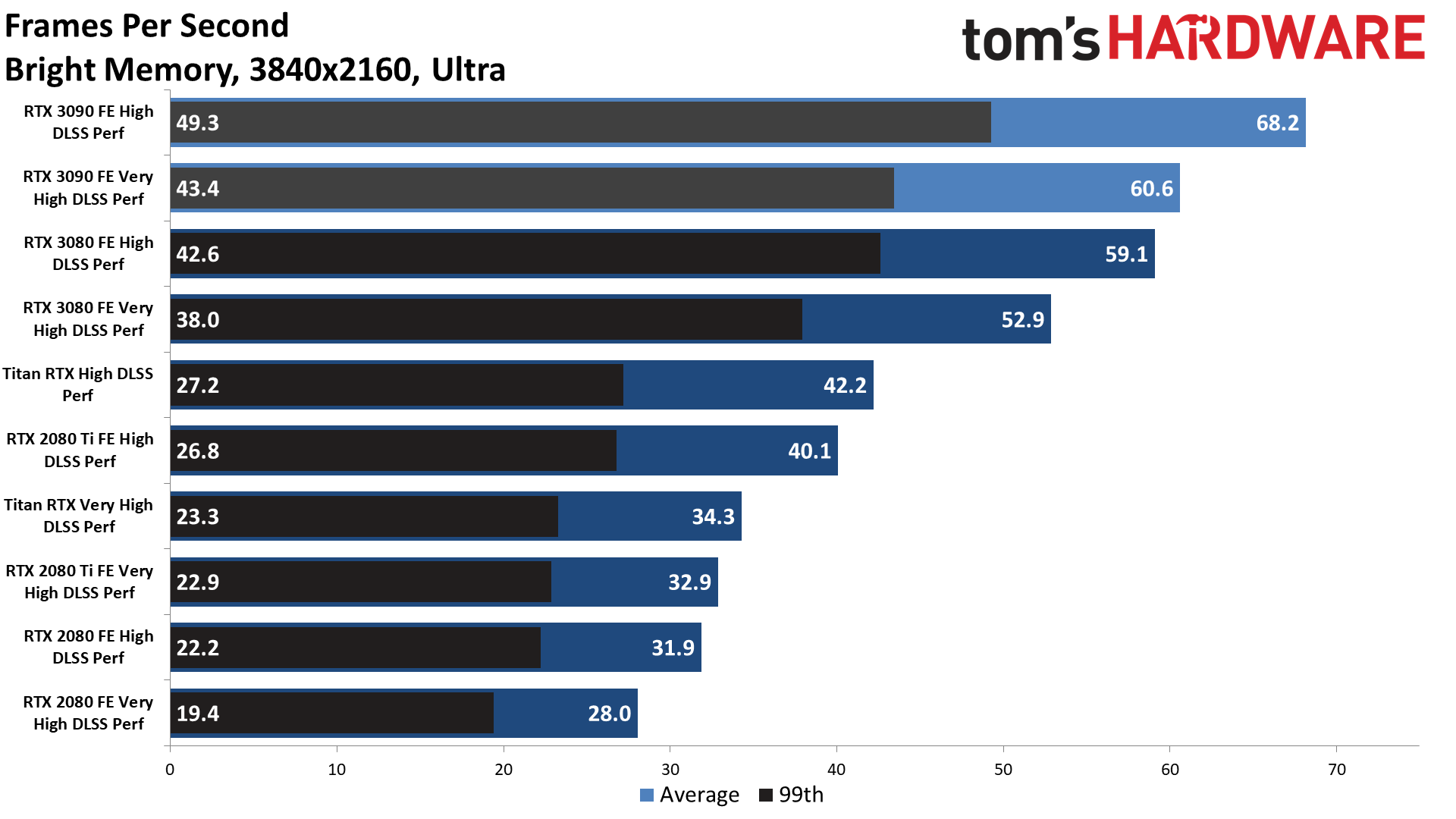

Bright Memory Infinite is another new benchmark, this time from FYQD-Studio. As with Boundary, it's eventually supposed to become a full-blown game, but that might take a year or two (or more). It includes a bevy of ray tracing options: reflections, refractions, shadows, ambient occlusion, order-independent transparency (OIT), and caustics, plus it supports multiple-bounce rays at higher settings, which makes for more realistic reflections and refractions at the cost of performance. We tested using the high and very high presets, again with DLSS 2.0 in performance mode (1080p upscaled to 4K).
Get Tom's Hardware's best news and in-depth reviews, straight to your inbox.
Average performance of the RTX 3090 just squeaks past the 60 fps mark, still with dips into the 40-50 fps range. Performance is also about 15% higher than the 3080 again. So far, 'limiting' our testing to only 4K ultra and below, we've yet to find a game where the 3080's 10GB of VRAM is a problem. That doesn't mean such a game doesn't exist, or won't exist at some point in the coming years, but even the most demanding games and graphics demos of today typically don't require more than 10GB at 4K.
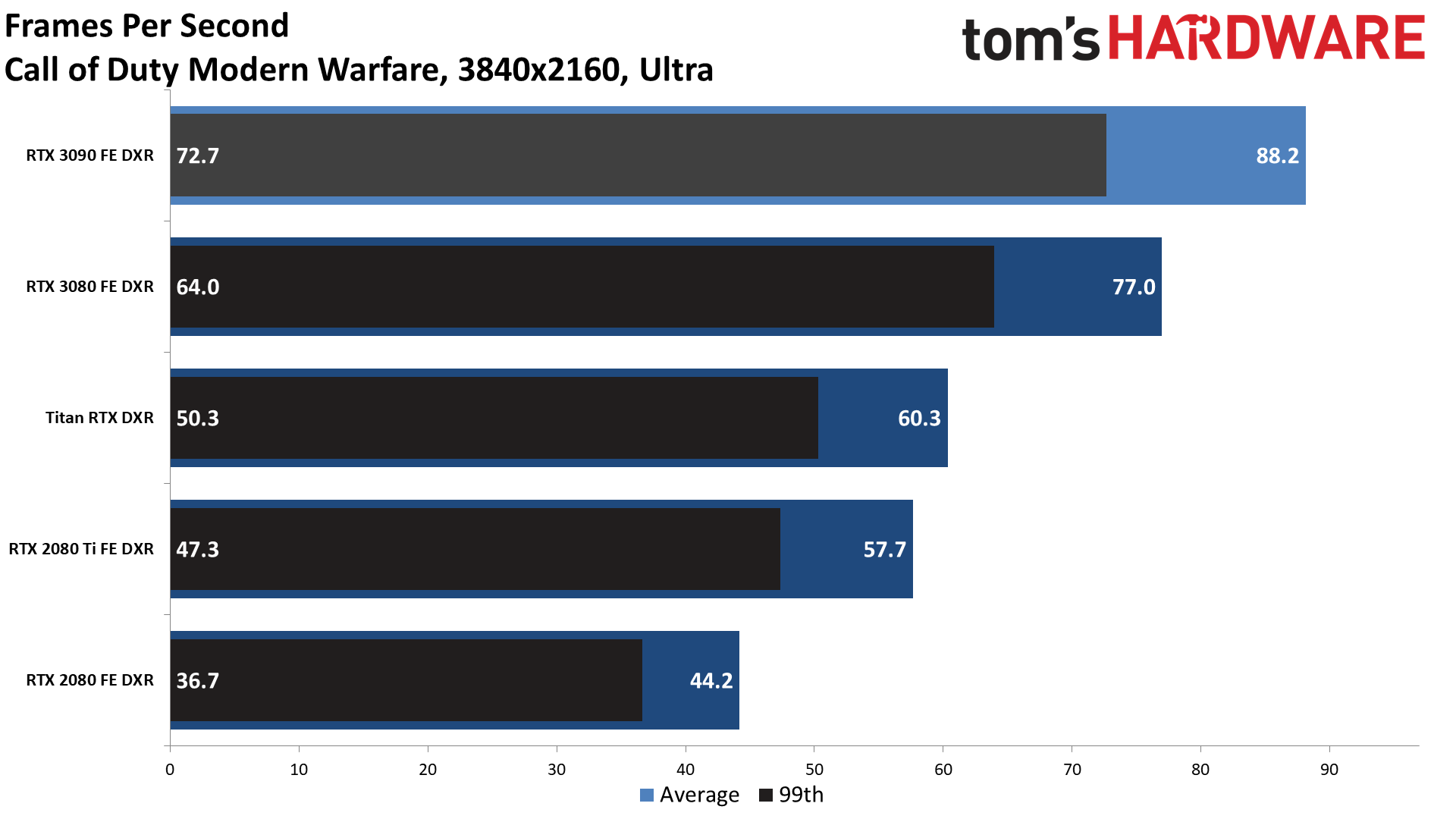
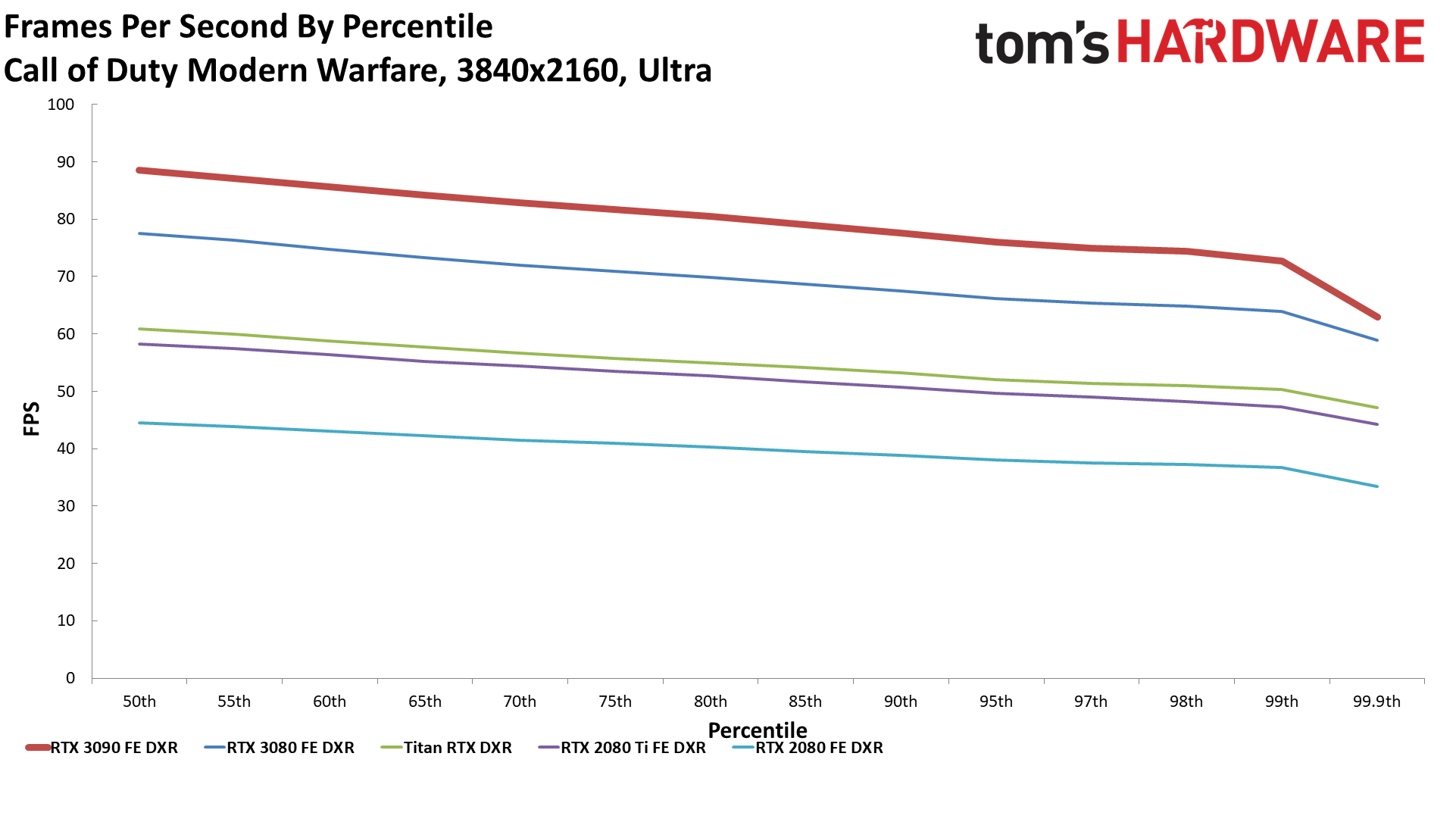
Call of Duty Modern Warfare includes ray tracing support, but only for shadows. It's also a bit distracting (to me, anyway) that the player character doesn't have a body or cast a shadow, making the RT shadows a less-than-stellar implementation. The 3080 managed to clear the 60 fps hurdle at 4K and maximum quality, and the 3090 builds on that lead by 15%. It's fast enough that you could enable ray tracing and still do fine on the multiplayer mode. Or, you know, set everything to minimum quality and play on a 360Hz display and maybe gain an advantage that way?

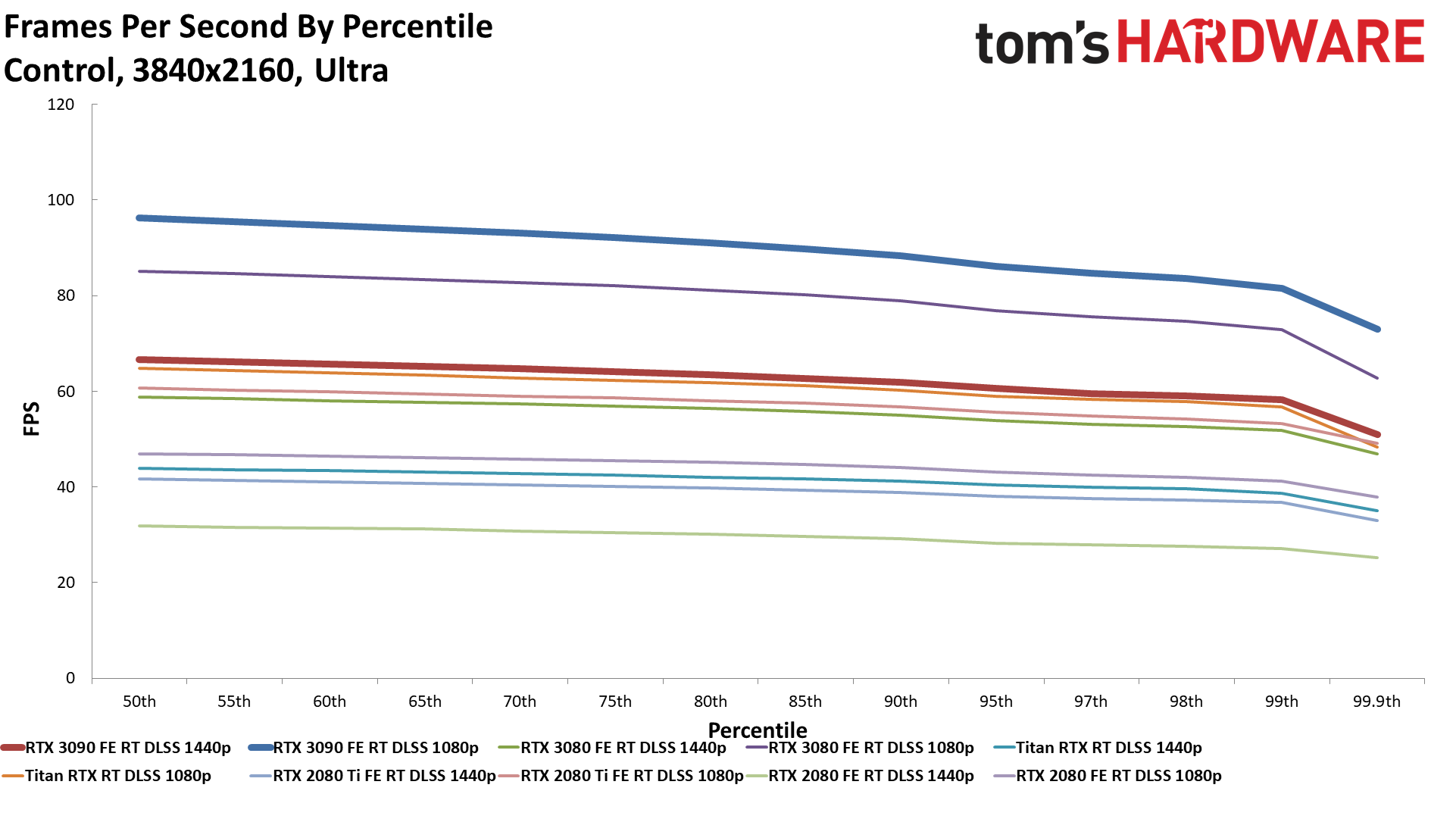
Like Bright Memory and Boundary, Control pushes more than one major ray tracing effect: reflections, diffuse lighting, transparent reflections, and ambient occlusion in this case. It was the first game to do so, and also one of the first implementations of DLSS 2.0. The RTX 3090 FE can basically manage maxed-out settings at 4K with 1440p DLSS upscaling and still maintain 60 fps (with a few dips below that mark). Or, if you use 1080p as the render resolution and upscale that to 4K, performance jumps to nearly 100 fps — about 13% faster than the 3080. It's also over twice the performance of the RTX 2080, something the 3080 didn't quite achieve.
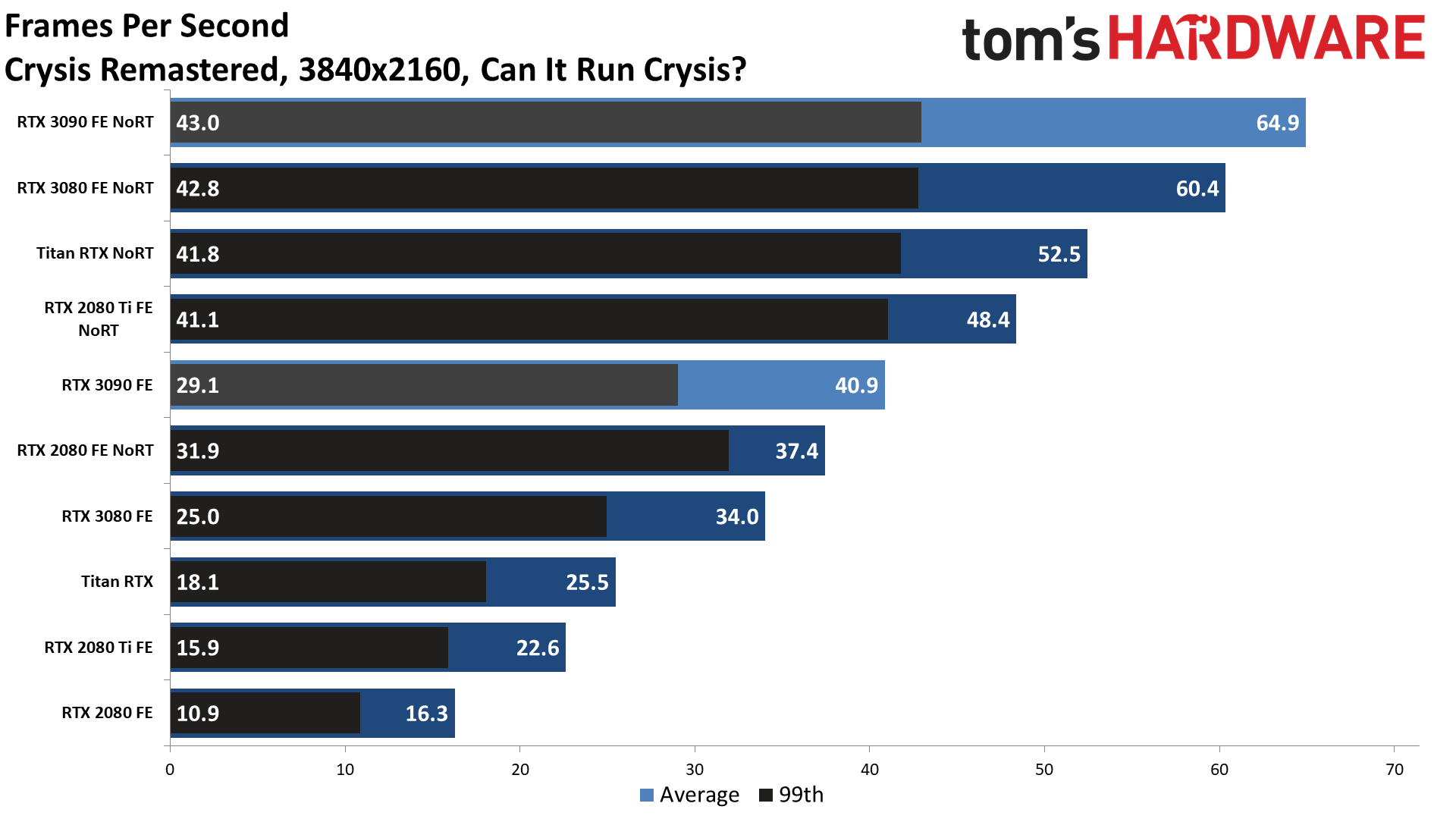
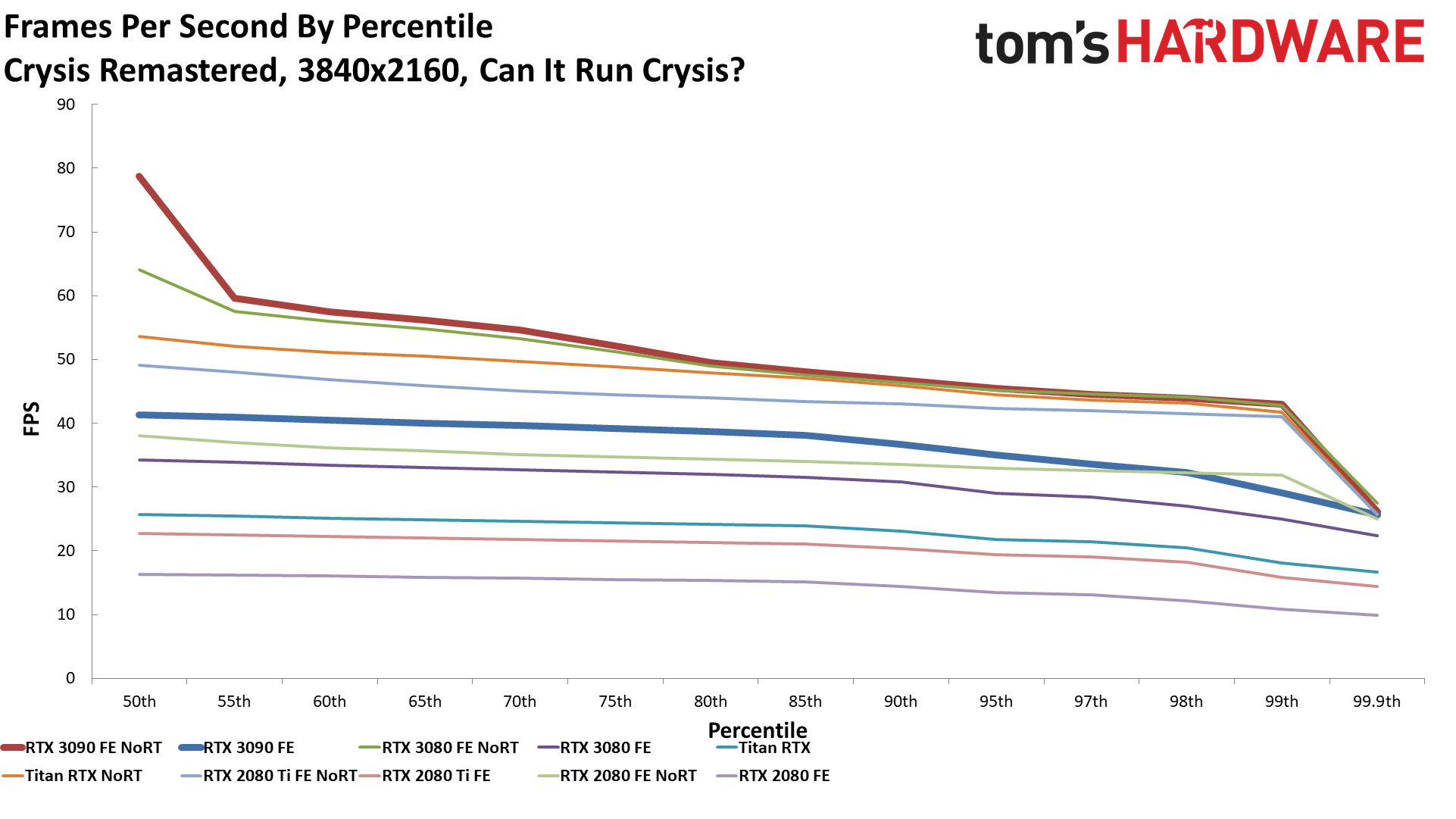
Yeah, we hear you: "But can it run Crysis?" The original shouldn't be a problem, but Crysis Remastered is another beast entirely. We tweeted about this the other day, though, and the ray tracing in the game seems to be … well, it's hard to spot the enhancements in a lot of areas. But the performance hit is still very much present. At 4K using the maximum "Can It Run Crysis?" settings, the 3090 plugs along at just 41 fps. That's still 20% faster than the RTX 3080 — our best result overall — but not really a smooth gaming experience. Supposedly a DLSS patch is coming, which might make 4K playable on the 3090, but we'll have to wait and see.
If you turn off the game's ray tracing setting — which interestingly provides a weird hodgepodge of software ray tracing and hardware-accelerated calculations, only it's built on top of DirectX 11 — performance jumps by over 50%. That's still only 65 fps on the 3090, and it will be interesting to see how long it takes before we have GPUs that can fully max out Crysis Remastered and average 60 fps or more at maximum settings. (My bet's on the RTX 5080 or equivalent, in about four years.)


Death Stranding ran quite well at 4K ultra settings even on RTX 20-series cards using DLSS 2.0, so the RTX 3090 unsurprisingly breezes along with a cool 146 fps average. That's 11% faster than the RTX 3080, and this is certainly a game where 8K with DLSS Ultra Performance mode could deliver smooth framerates. If you have an 8K TV and the game gets a DLSS 2.1 patch, at any rate.
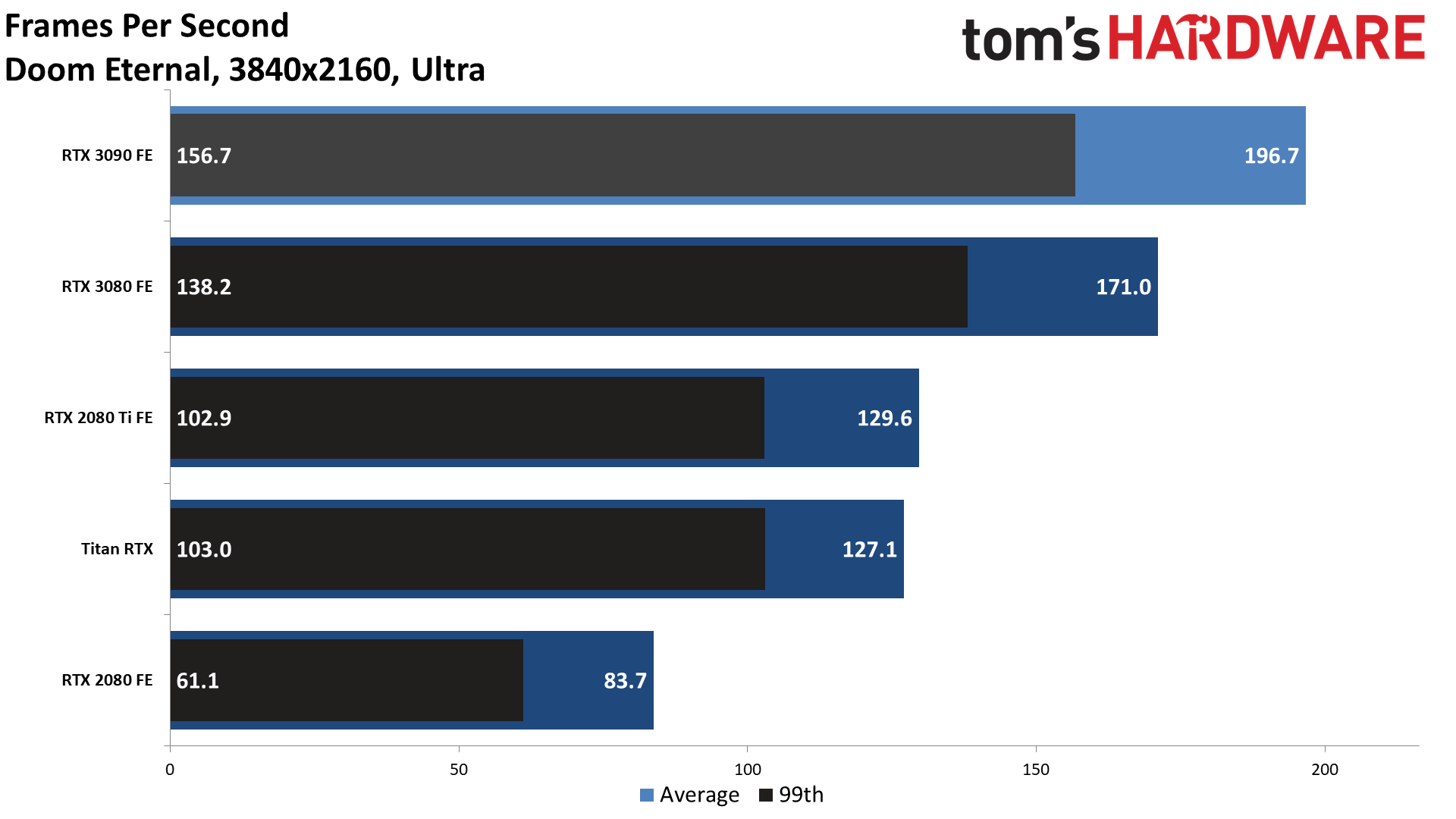
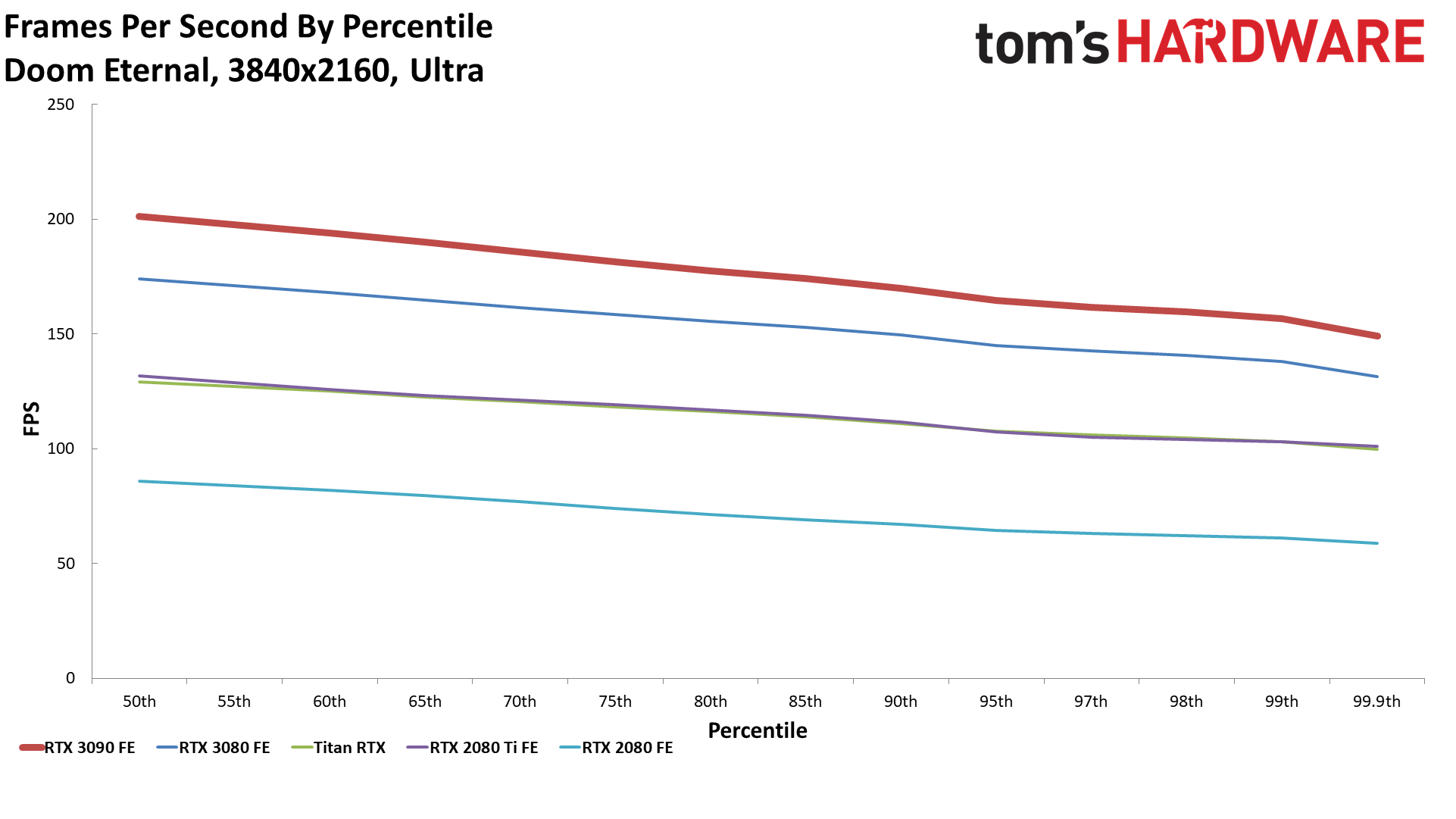
Doom Eternal is another game that uses the Vulkan API, and performance is excellent across all the tested GPUs. Even at the maximum ultra nightmare settings, everything we've tested here easily breaks 60 fps. The RTX 3090, though, is getting very close to 200 fps and delivers 15% more performance than the RTX 3080.
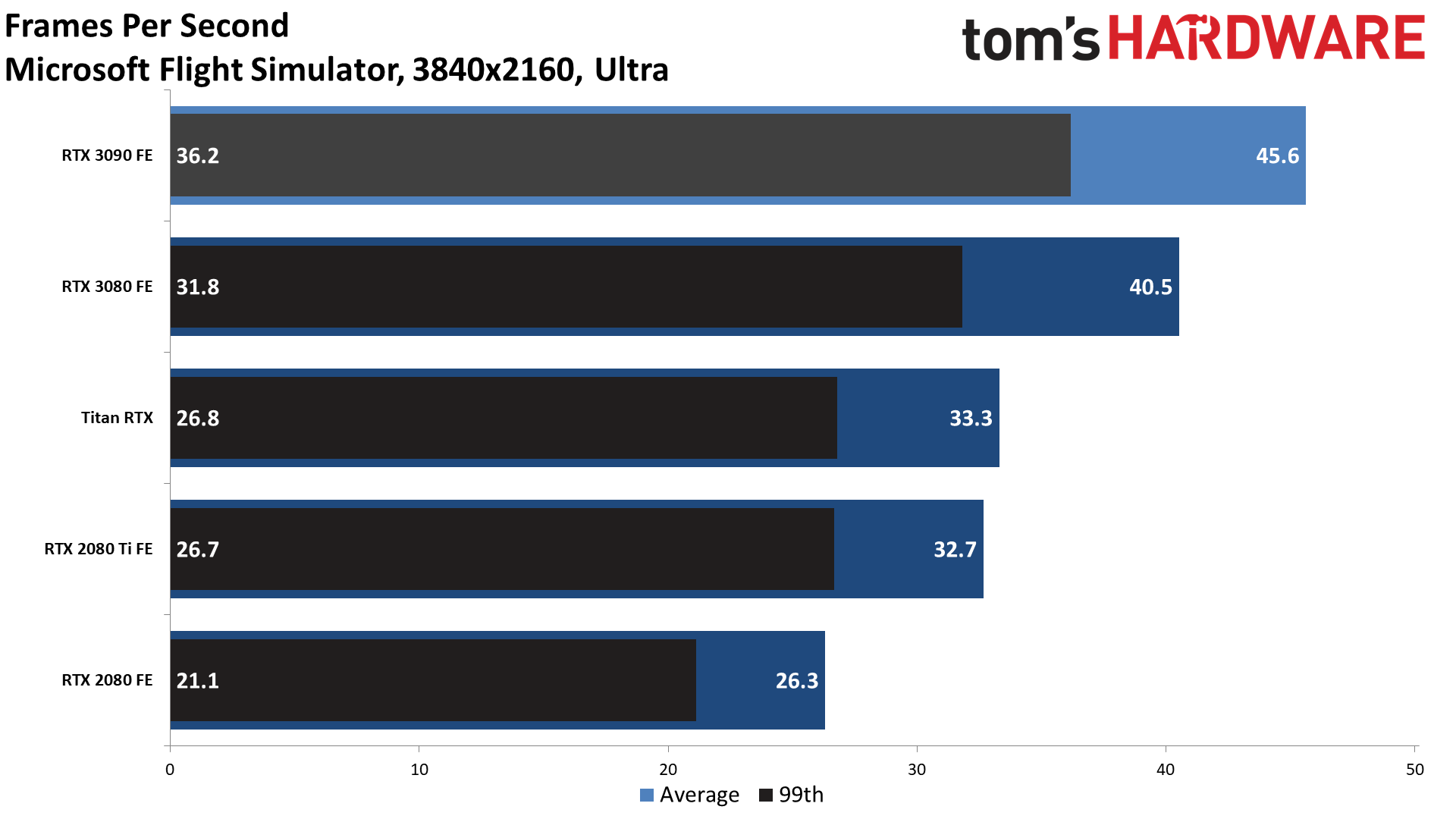

Our Microsoft Flight Simulator 2020 performance analysis found this to be one of the most taxing games around, particularly for CPUs. Still, having lots of VRAM and running at 4K ultra mostly pushes the bottleneck back to the GPU. The RTX 3090 delivered 46 fps, which is still 13% faster than the 3080 and gets close to the 52 fps limit of the ultra settings that we ran into at 1080p and 1440p. The game has a DX12 patch supposedly coming, which might boost performance beyond 60 fps at ultra quality, but we'll have to see it to believe it.


We also did a Horizon Zero Dawn performance analysis and found it to be more demanding than Death Stranding, despite using the same engine. Blame the port, or the open world design, or whatever. The 3090 is the first GPU to fully eclipse 60 fps at 4K ultra — meaning even minimum fps stays above that mark. Performance is also 16% higher than the 3080, and minimum fps (99th percentile frametime fps) is 25% faster than the 3080, suggesting this might be a game that's actually making use of more than 10GB — or that it's caching more data into VRAM to smooth out the occasional stutter, more likely.
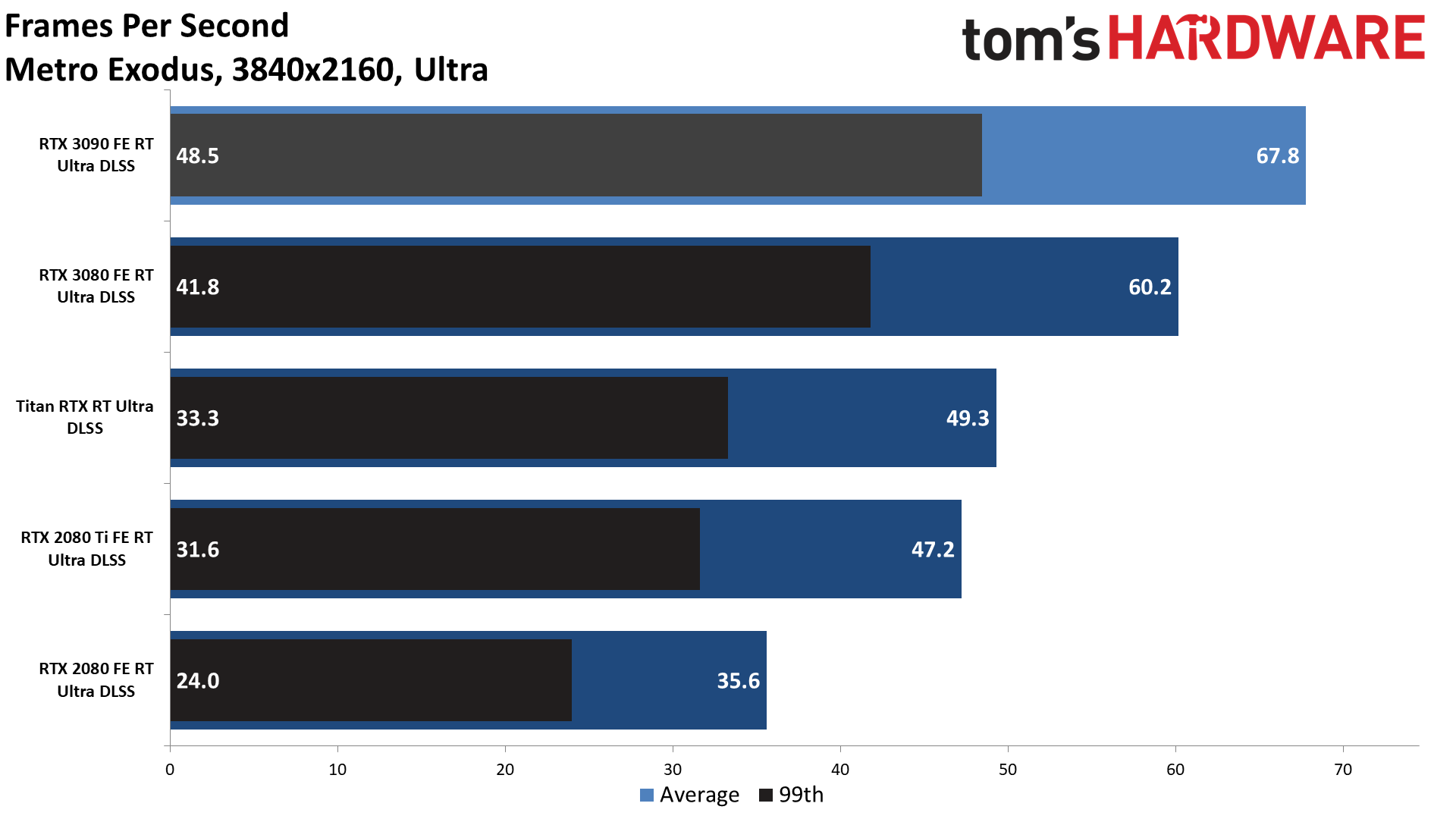
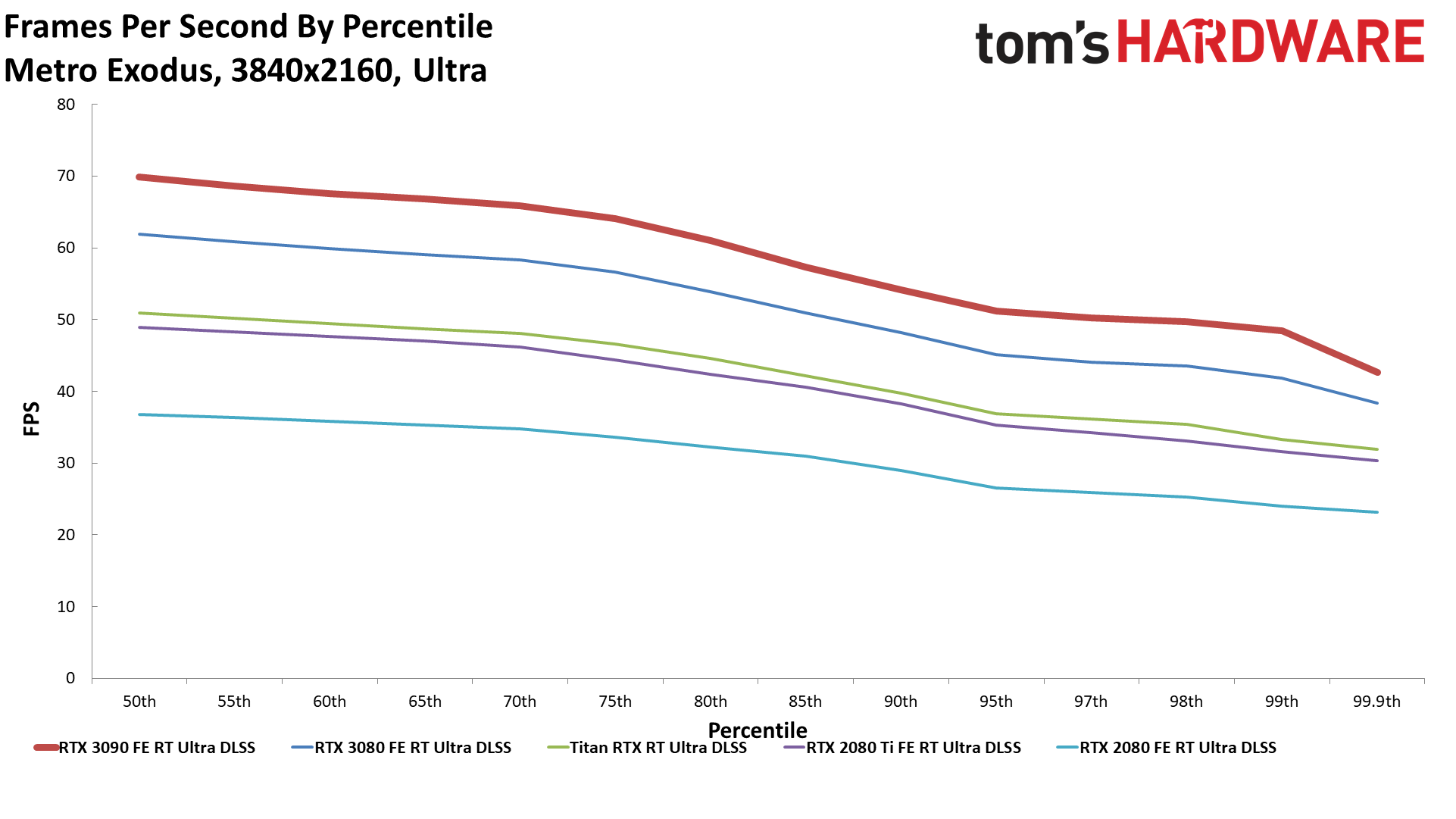
We're back to Metro Exodus, this time with ultra quality ray-traced global illumination and DLSS 1.0 enabled. At these settings, Metro is still a beast to run, and even the 3090 and 3080 barely break 60 fps. The 3090 is 13% faster, but what we'd really like to see is DLSS 2.0 support and maybe some additional fine-tuning of the ray tracing effects. Sadly, that ship has likely sailed — or if you prefer, the train has left the station — as 4A Games is working on other projects these days.
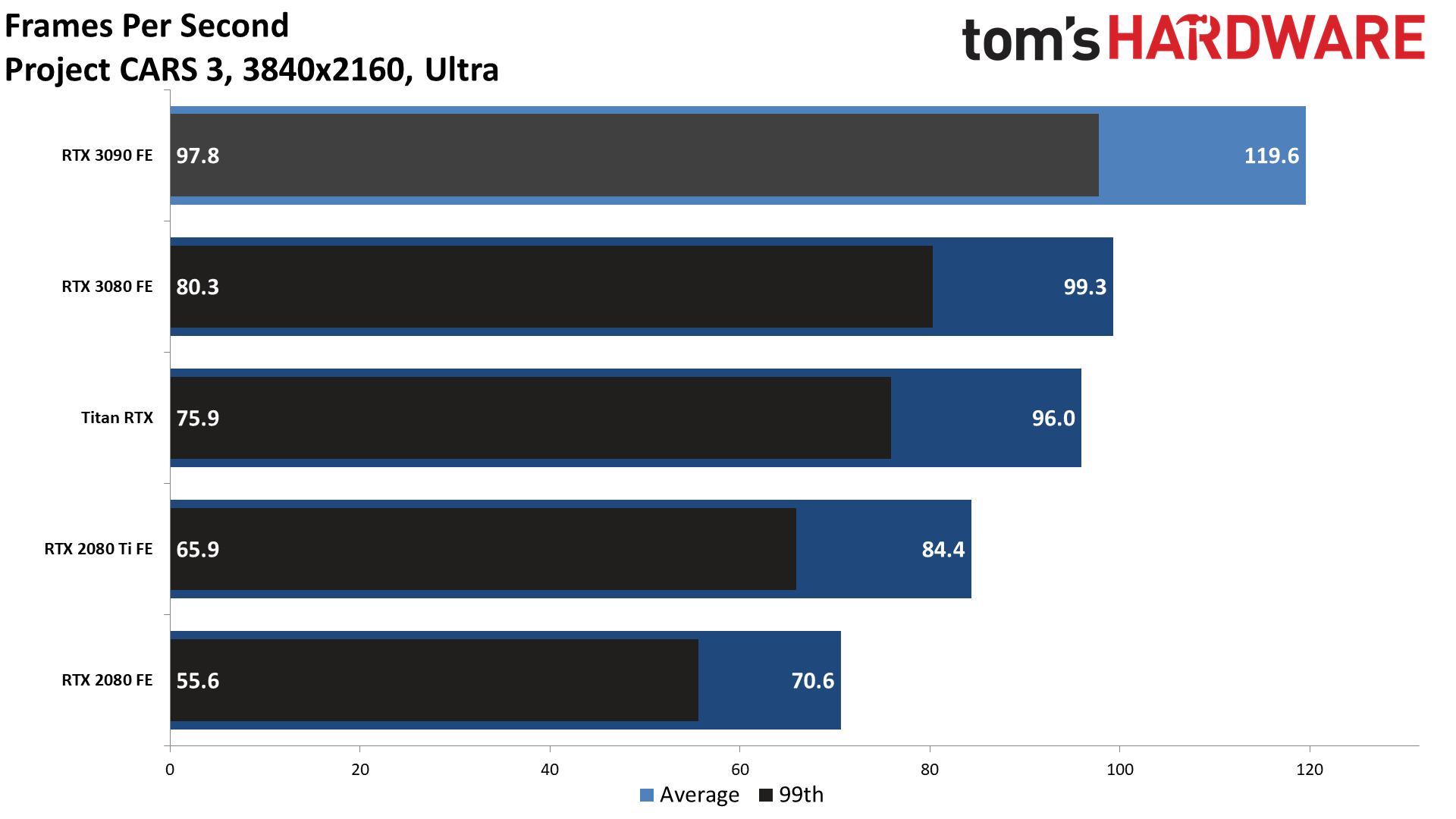
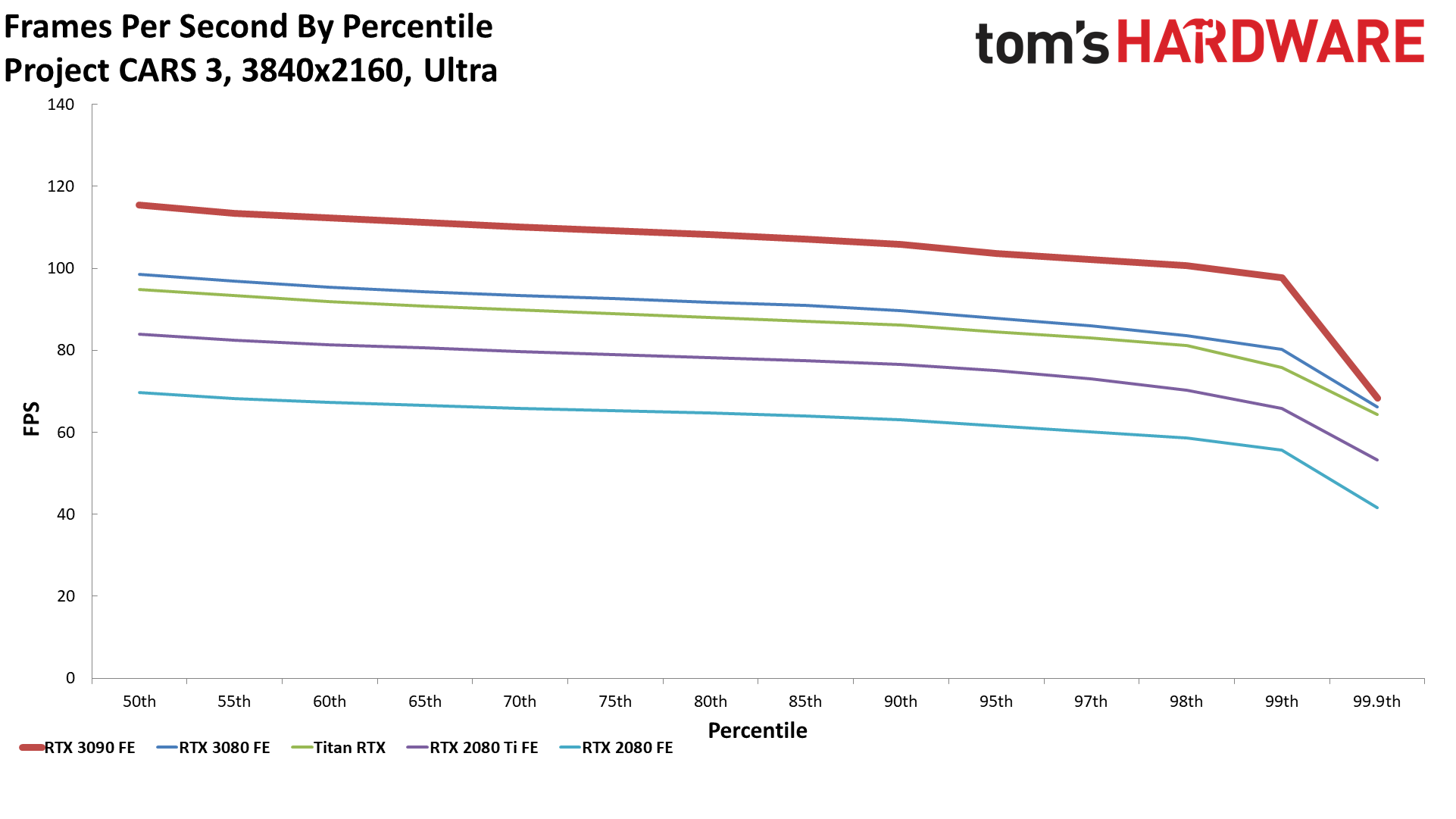
Our Project CARS 3 performance analysis has results from a bunch more GPUs and CPUs, and we wanted to see how the 3090 stacked up. Surprisingly, this is another big win for 3090 and its 24GB VRAM, with performance that's 20% higher than the 3080 and 99th percentile minimum fps that's 22% faster. The game seemed to be more CPU limited than others we've tested, but at 4K ultra, it still makes good use of the fastest GPUs available.
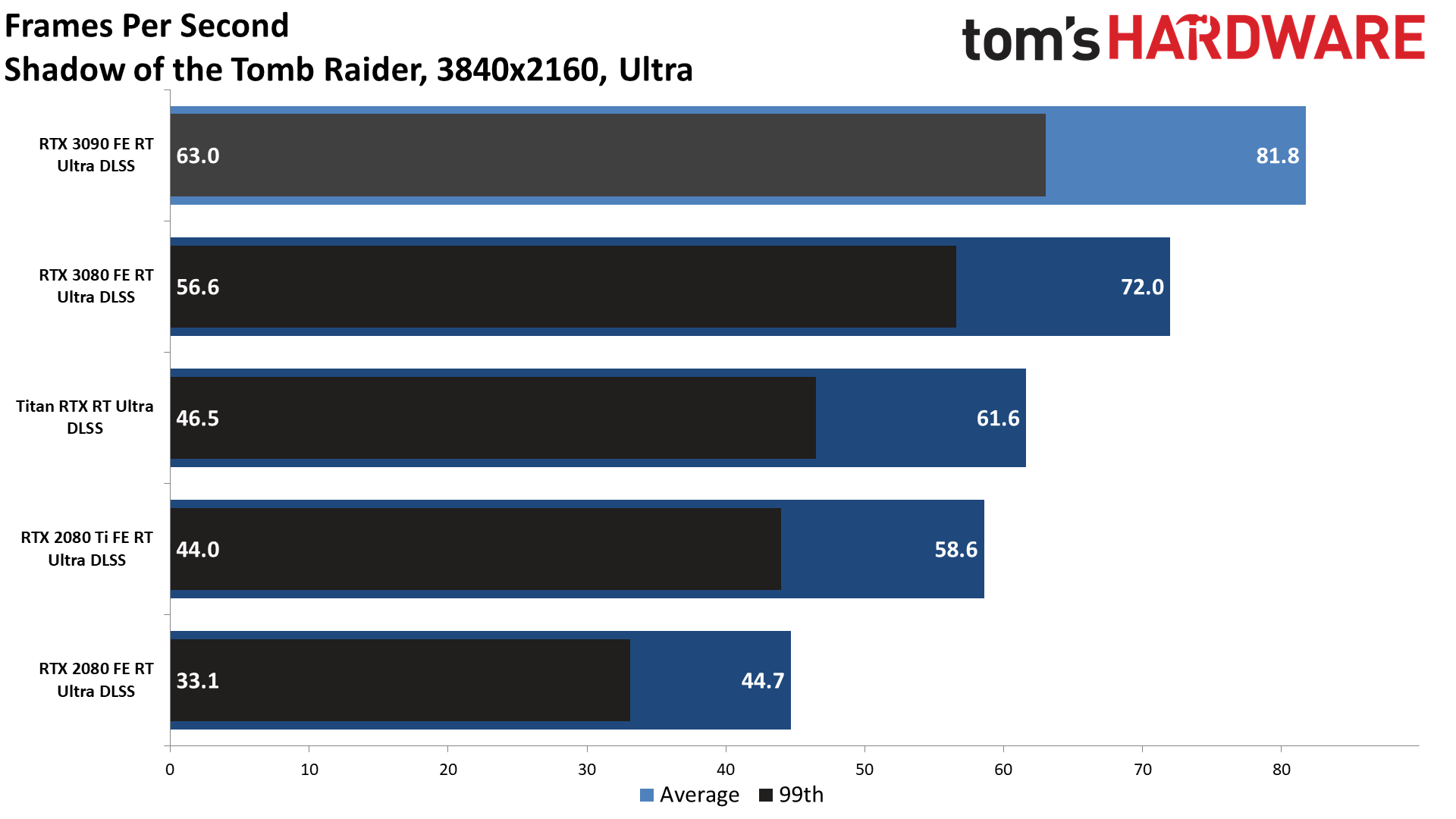
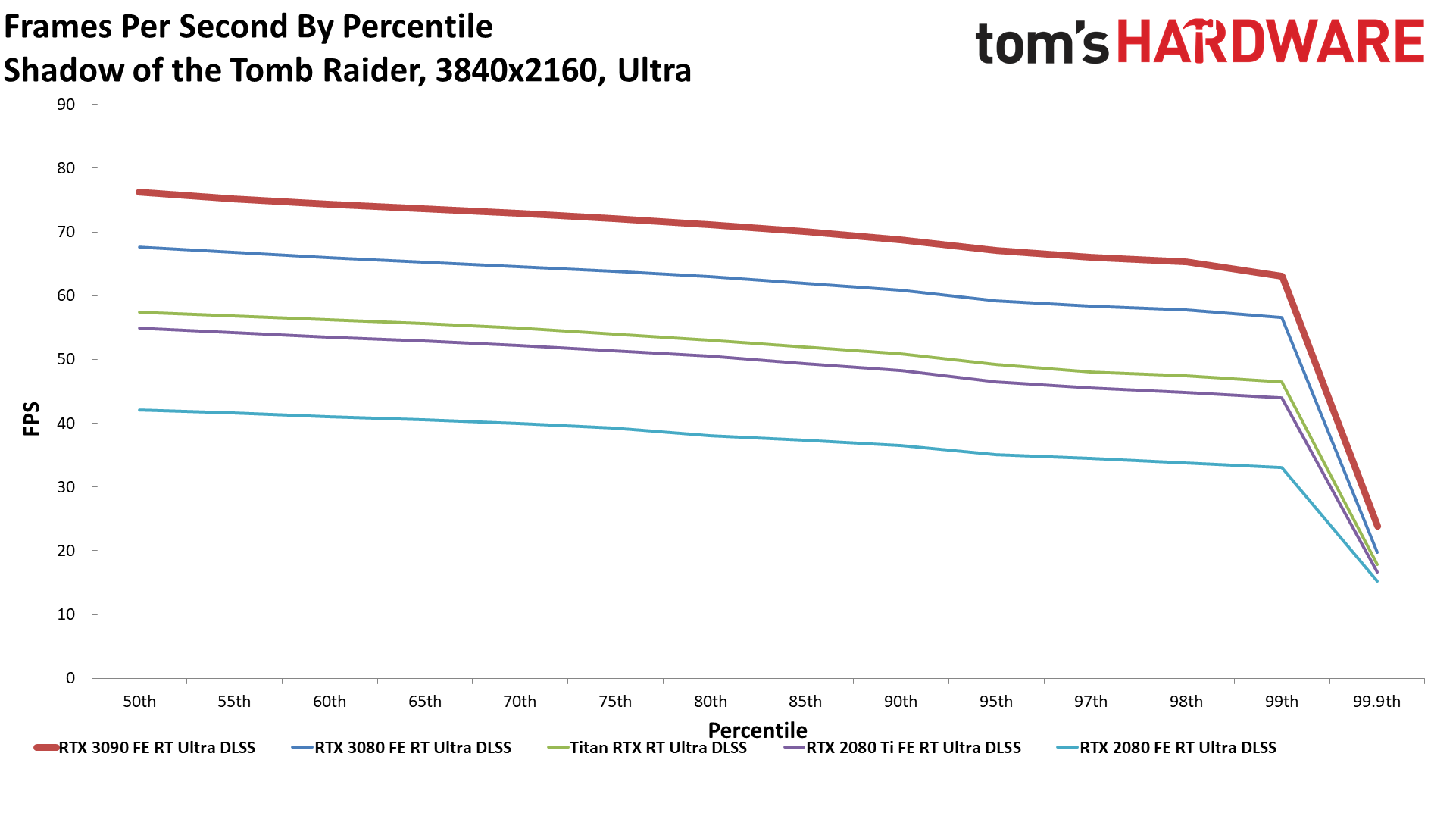
Shadow of the Tomb Raider was only the third game to add RTX enhancements back in 2019, but they arrived over six months after the game launched — too little, too late for many. Still, at 4K highest settings with ultra ray traced shadows, we've yet to fully surpass the 60 fps mark. Until the RTX 3090, that is. With minimum performance of 64 fps, 4K highest settings with ray tracing and DLSS also falls to the 3090, which bests the 3080 by 14%. Again, it would be nice if some of these early DLSS 1.0 games could get DLSS 2.0 patches, but that seems unlikely at best. It would also be interesting to see some games go back and add more than one RT effect — the devs could chalk it up as practice for the sequel! Dreams are free at least.

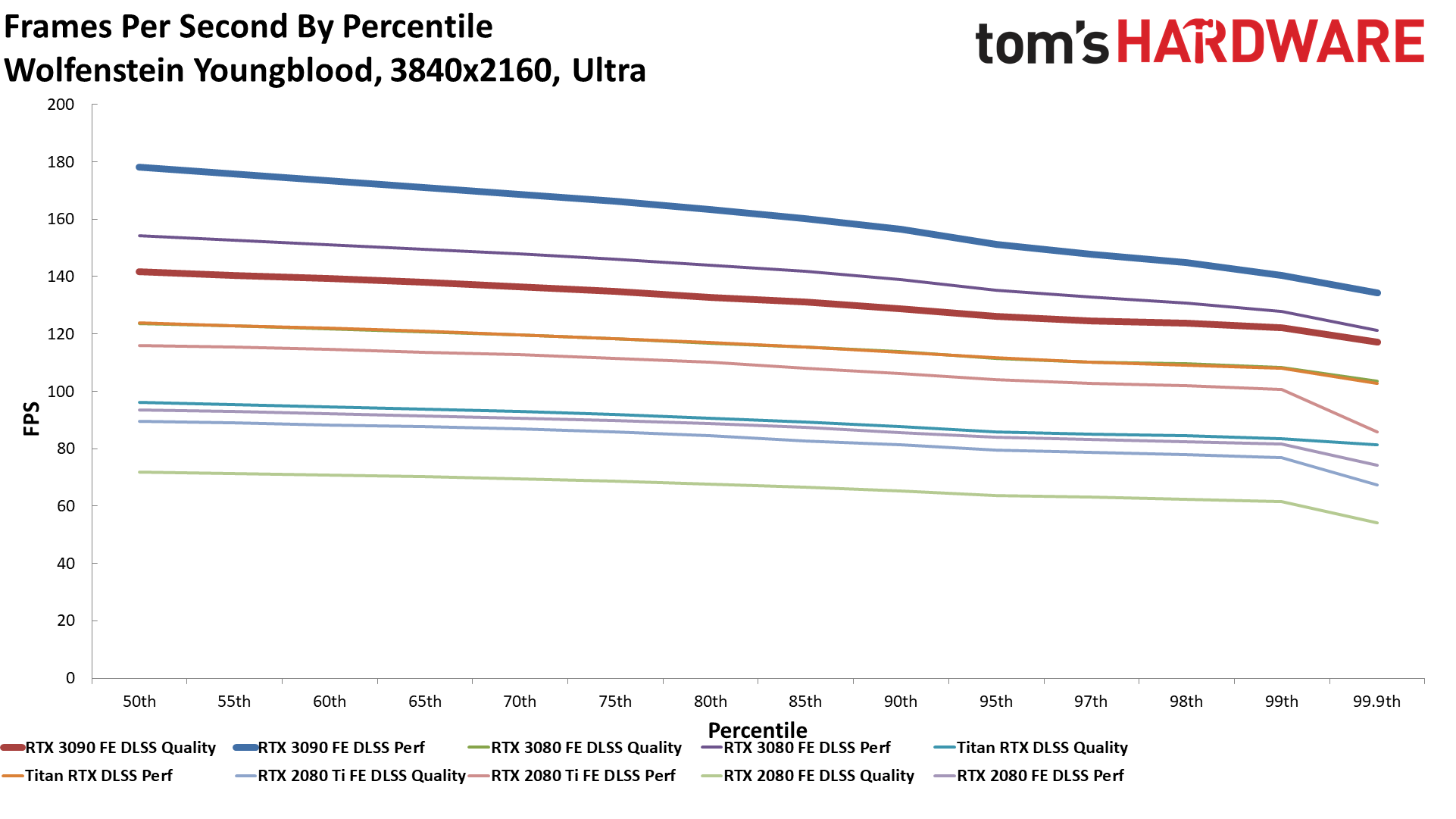
Last we have Wolfenstein Youngblood, the fourth Vulkan game and the first to implement VulkanRT effects. With DLSS 2.0 running in quality mode, the 3090 ends up 15% faster than the 3080 and just about makes it past the 144 fps mark. Drop to DLSS performance mode and performance shoots up to 177 fps — again, 15% faster than the 3080 — so any 4K 144Hz displays can finally strut their stuff. We do have to wonder what it is about Vulkan that often leads to markedly better performance. Is it the API, or just the developers putting in more time on optimizations? Either way, three of the four Vulkan games we tested (Red Dead Redemption 2 being the exception) boasted impressive performance figures.
Current page: GeForce RTX 3090: Bonus Round 4K Ultra, Ray Tracing, and DLSS Gaming
Prev Page GeForce RTX 3090: Built for 4K and Beyond Next Page GeForce RTX 3090: Pro-Viz Benchmarks and Compute
Jarred Walton is a senior editor at Tom's Hardware focusing on everything GPU. He has been working as a tech journalist since 2004, writing for AnandTech, Maximum PC, and PC Gamer. From the first S3 Virge '3D decelerators' to today's GPUs, Jarred keeps up with all the latest graphics trends and is the one to ask about game performance.
-
VforV "Titan-class card" - again with this nvidia BS?Reply
It's not, it's a catchphrase from nvidia and the media keeps playing this tune. It's only a more expensive 3080 Ti, which will be proven soon. A halo product for people with more money than sense.
"Fastest current graphics card, period" - Wrong, it's not, it's based on the game and if it's optimized for nvidia (DLSS) or AMD (and no DLSS). In the first case it wins in the latter one it gets beaten by RX 6800 XT and RX 6900 XT, sometimes by a mile... as much as it beats them in the first case with DLSS ON, but then AMD does it by raw power. So it's 50/50, period.
"8K DLSS potential" - yeah, sure "potential". If you count dreaming of 8k gaming potential too, then yes. Again nvidia BS propagated by media still.
"Needs a 4K display, maybe even 8K" - no it does not "need" an 8k display unless you want to be majorly disappointed and play at 30 fps only. That is today, with today games and today's graphics demands, but tomorrow and next gen games you can kiss it goodbye at 8k. Another nvidia BS, again supported by the media.
GJ @ author, nvidia is pleased by your article. -
Loadedaxe Titan Class card? No offense, but to Nvidia it is. The rest of the world its a 3080Ti.Reply -
HideOut Mmmm 2 months late for a review? Whats happened to this company. Late or missing reviews. Nothing but rasberry Pi stuff, and sister publication anantech is nearly dead.Reply -
Blacksad999 Reply
Yeah, the Raspberry Pi stuff is getting annoying. They brought out their 5800x review way after the fact, too. Kind of odd. I understand it's a difficult year to review things, but months later than most review sites isn't a good look when that's supposed to be the sites specialty.HideOut said:Mmmm 2 months late for a review? Whats happened to this company. Late or missing reviews. Nothing but rasberry Pi stuff, and sister publication anantech is nearly dead.
